Burmese pythons and kingsnakes are both predatory snake species that reside in Florida. While one of these species is native to the state, the other is an invasive species. However, even a home-field advantage might not help one snake species from defeating the other. Discover facts about the Burmese python and the kingsnake and find out which snake would win in an epic fight.
Background on Burmese Pythons
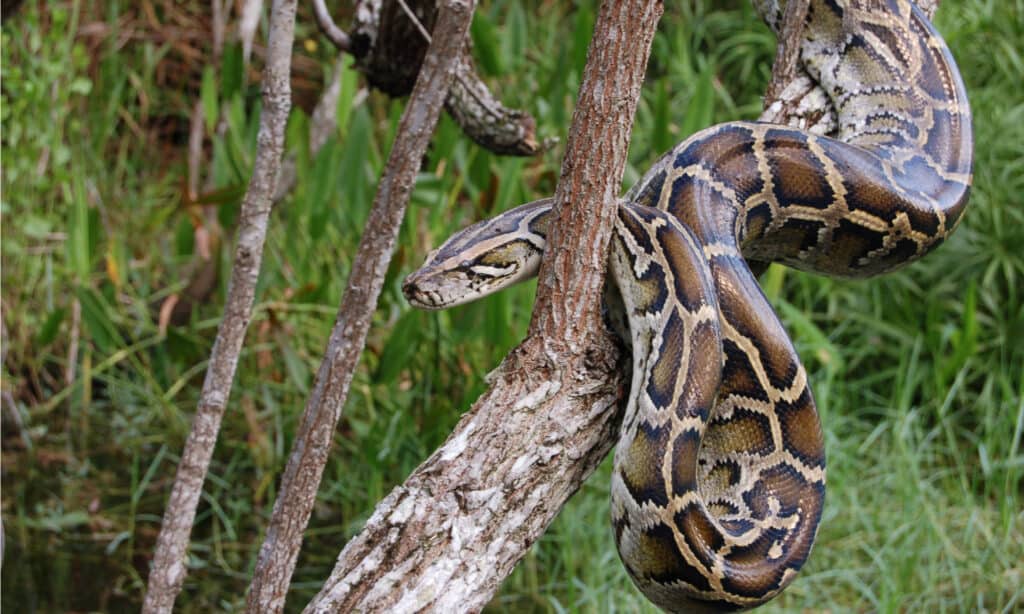
As an invasive species in Florida, you’ll see Burmese pythons most easily in the Everglades.
©Heiko Kiera/Shutterstock.com
Burmese pythons have recently become an invasive species in the state of Florida. These snakes are not originally from the United States, though. Rather, Burmese pythons come from their native home of southern and southeastern Asia. Most Burmese pythons in Florida reside in southern Florida and in scattered areas around central Florida. Luckily, though, the likelihood that Burmese pythons would migrate further North into bordering states is low.
Burmese pythons typically measure between 10 and 16 feet in length. They are a massive snake breed with light brown or tan scales dotted with darker brown spots. The heads of Burmese pythons are a dark brown color, but they have light brown stripes that create a V-shape on their heads. As a Burmese python ages, the colors on their body will begin to fade.
The habitat of a Burmese python includes wetlands, marshes, prairies, and bodies of water like lakes and ponds. However, the Burmese python is not limited to these locations and can invade other habitats so long as the conditions support their survival. The most notorious place to find a Burmese python in the state of Florida is within the Florida Everglades.
Diet of the Burmese python includes small and large mammals such as rodents and deer, respectively. They will also eat birds of almost any kind. In rare cases, the Burmese python will be able to take down whole alligators through the power of constriction. Burmese pythons will typically lay eggs during the summer months. The number of eggs that a female Burmese python can lay averages between 11 and 87 eggs.
Dangers of the Burmese Python
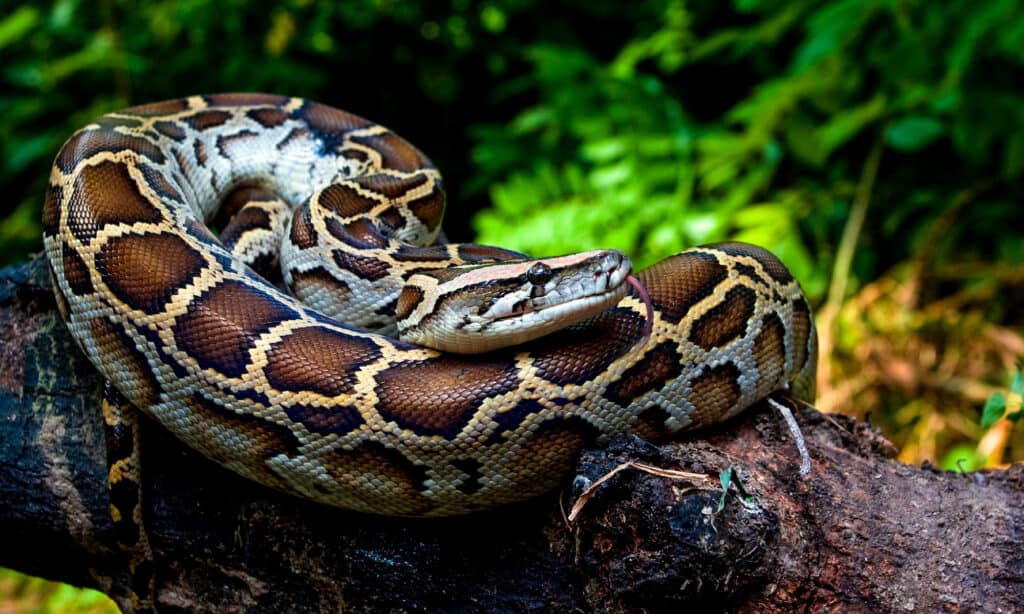
As vicious as Burmese pythons can be, they generally don’t attack unless provoked.
©dwi putra stock/Shutterstock.com
Burmese pythons are not venomous, but they will bite if they feel threatened as a form of self-defense. While smaller pythons are not a threat to humans and domesticated animals, large Burmese pythons are formidable. Their bite is powerful, and they can swallow something as small as a rodent up to a cat or dog.
Burmese pythons can camouflage well into their surroundings. Furthermore, these snakes are prone to lying low, concealing themselves from any possible threat. While a Burmese python will not attack unless provoked, their attacks are vicious and can be fatal. Burmese pythons will both bite and constrict their prey. Constriction allows a Burmese python to suffocate their prey by squeezing them tighter and tighter before swallowing them whole.
Burmese Python Effects on Florida’s Environment

After being irresponsibly released into Florida’s natural enviornment, Burmese pythons now inhabit areas of the state, including the Everglades.
©GagliardiPhotography/Shutterstock.com
In the 1980s, people began to import Burmese pythons into Florida through the exotic snake trade. Miami was a main center for the exotic snake trade. Due to the Burmese python’s formidable size, many owners could not continue to handle such massive snakes. Thus, several owners irresponsibly released these snakes into Florida’s natural environment. Another incident of Burmese python release in Florida occurred when Hurricane Andrew destroyed a python breeding facility in Florida. Hurricane Andrew both left the facility destroyed and led to the escape of numerous Burmese pythons into surrounding natural areas.
While the Burmese python might not pose a significant threat to humans residing in south and central Florida, they do threaten the stability of numerous environments. Female Burmese pythons can lay up to 100 eggs annually. Furthermore, there is no larger predator in and around the Everglades that threatens the Burmese python. Thus, these snakes are at the top of the food chain.
In the Everglades, many are concerned about the adverse effects that Burmese pythons will have on animals and habitats within the state. Factors like competition for food and overall predation have caused certain animal populations within the Everglades to decline drastically due to the presence of the Burmese python. For instance, raccoon, bobcat, and opossum populations have all decreased between 87% and 99%. Furthermore, species like the fox and cottontail rabbit have been practically wiped out by the introduction and reproduction of the Burmese python in this region.
Now, officials have no estimate as to how many Burmese pythons might be slithering through and around the Everglades. The species is so invasive that they have been able to migrate to areas outside of the Everglades. Due to factors like climate change, temperatures north of the Everglades have become suitable for the survival of this species. Thus, Burmese pythons have been able to expand their populations outside of southern Florida, allowing for an even more unreliable estimate of how many pythons reside in the state.
Background on Kingsnakes
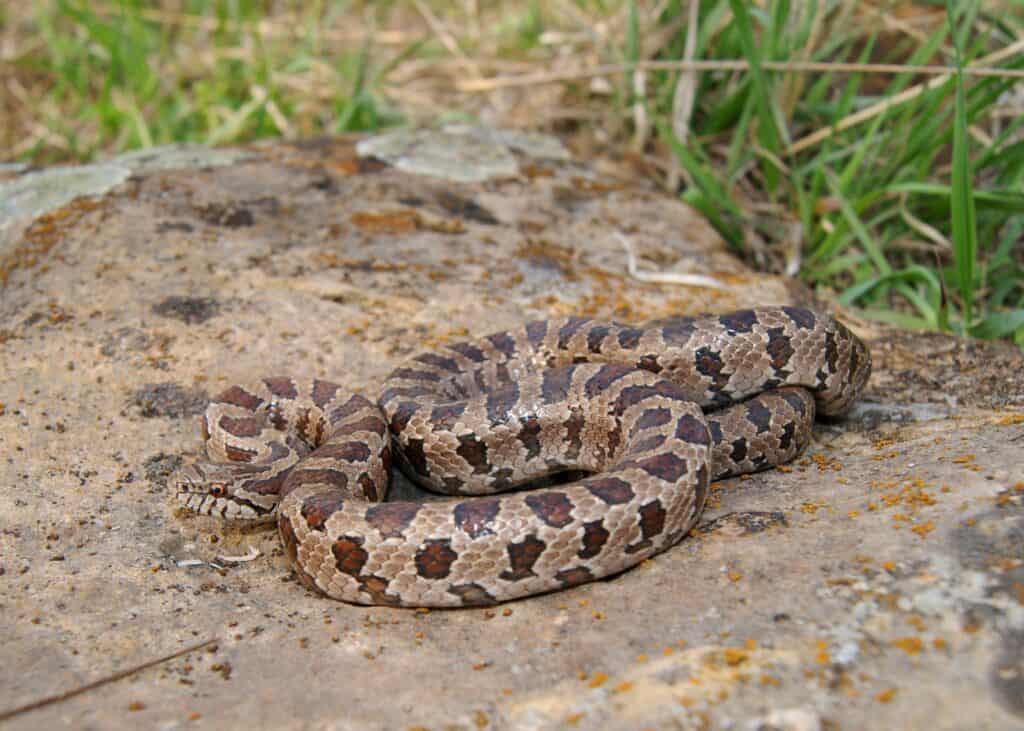
Kingsnake refers to a number of species within the
Lampropeltisgenus. Pictured is a yellow-bellied kingsnake.
©Matt Jeppson/Shutterstock.com
The kingsnake is not a single species. Rather, the term kingsnake defines any snake of moderate size between the countries of Canada and Ecuador. It is estimated that between six and 30 kingsnake species exist. These snakes average a length between 3.3 and 4.9 feet in length. Thus, these snakes are not nearly as large as the Burmese python. Like the Burmese python, kingsnakes are not venomous.
Although kingsnake describes a group of species, there are specific kingsnake species that pervade the United States. The common kingsnake has black or dark brown scales with yellow or white designs that give them a patterned look. On the other hand, the California kingsnake can have a ringed pattern or a striped pattern. Nevertheless, both species belong under the kingsnake definition.
Another kingsnake species, the common milk snake, covers a wide range of geographic territory. They span from the United States and Canada border down to the northern portion of South America. The common milk snake can measure up to 6.2 feet in length. On the other hand, the scarlet kingsnake resides mainly in the southeast portion of the United States. Both snake species are unique because they look like coral snakes, which are venomous. Thus, many steer clear of these non-venomous snakes, mistakenly thinking that they might inflict poison on them.
Dangers of the Kingsnake
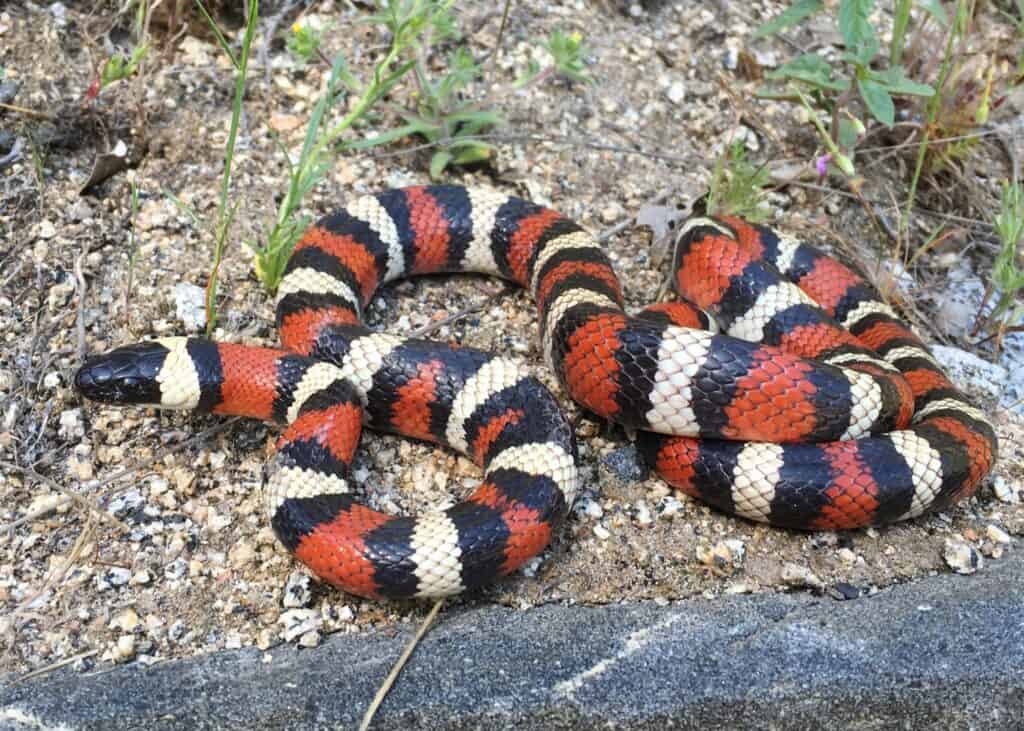
Like Burmese pythons, kingsnakes constrict their prey. Pictured here is a California mountain kingsnake.
©Matt Jeppson/Shutterstock.com
Kingsnakes constrict their prey, suffocating them and then swallowing them. The prey of the kingsnake includes small animals, but they will eat almost anything. From birds to lizards or from mammals to other snakes, the kingsnake is not limited in its options for prey.
The term kingsnake comes from their ability to often eat other kinds of snakes. Copperheads and rattlesnakes have fallen victim to the kingsnake’s constriction methods on numerous occasions. Furthermore, what makes the kingsnake unique is that they are immune to the poison that the copperhead or rattlesnake might try to impose on them in defense. Thus, the kingsnake can overcome the two species, showing how power can be greater than poison. Even more shocking is that kingsnakes have a habit of devouring other kingsnakes in a cannibalistic manner.
Kingsnake Versus Burmese Python: Who Would Win?
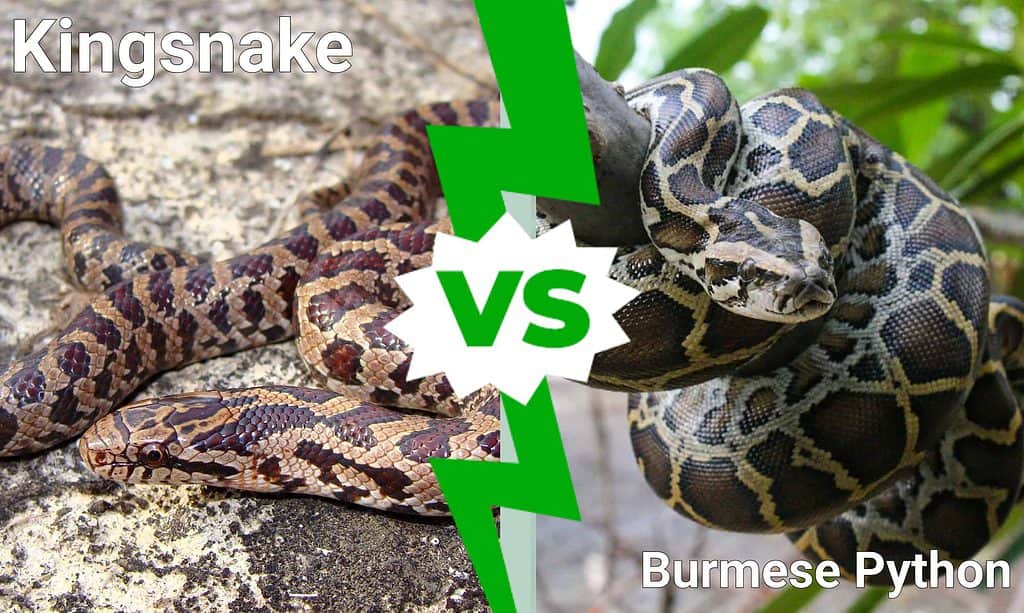
In an epic battle between a kingsnake and a Burmese python, it is likely that a Burmese python would come out victorious. Although kingsnakes are known for eating other snake species with regularity, they are simply no match for the Burmese python’s incredible size. Burmese pythons are between two to three times larger and longer than the average kingsnake. Therefore, it’s unlikely that a kingsnake could overpower this incredible predator.
Furthermore, neither species of snake is venomous. Both the kingsnake and the Burmese python rely on constriction techniques to overcome their prey. The kingsnake has experience with constricting smaller animals like birds and reptiles while the Burmese python has taken down entire alligators and deer. Thus, if a snake of great size and skill like the Burmese python can overcome larger animals, it’s highly likely that it would be able to take down another, smaller constrictor like the kingsnake.
Up Next…
- Epic Battles: Burmese Python versus Nile Crocodile
- Could Climate Change Bring Giant Snakes into the United States?
- 6 King Snakes in Texas
The photo featured at the top of this post is ©
Discover the "Monster" Snake 5X Bigger than an Anaconda
Every day A-Z Animals sends out some of the most incredible facts in the world from our free newsletter. Want to discover the 10 most beautiful snakes in the world, a "snake island" where you're never more than 3 feet from danger, or a "monster" snake 5X larger than an anaconda? Then sign up right now and you'll start receiving our daily newsletter absolutely free.
Sources
- Britannica, Available here: https://www.britannica.com/animal/king-snake
- Florida Museum of Natural History, Available here: https://www.floridamuseum.ufl.edu/florida-snake-id/snake/burmese-python/
- United States Geological Survey, Available here: https://www.usgs.gov/faqs/how-have-invasive-pythons-impacted-florida-ecosystems
- Adam Janos, Available here: https://www.history.com/news/burmese-python-invasion-florida-everglades
FAQs (Frequently Asked Questions)
Where are Burmese pythons located?
Burmese pythons are an invasive species found in and around Everglades National Park in Florida.
Which snake species is larger: the kingsnake or the Burmese python?
The Burmese python is between two and three times larger than the kingsnake. Most Burmese pythons measure between 10 and 16 feet long.
What are examples of kingsnake species?
Kingsnake species include the common milk snake, the common kingsnake, and the scarlet kingsnake.
Thank you for reading! Have some feedback for us? Contact the AZ Animals editorial team.







